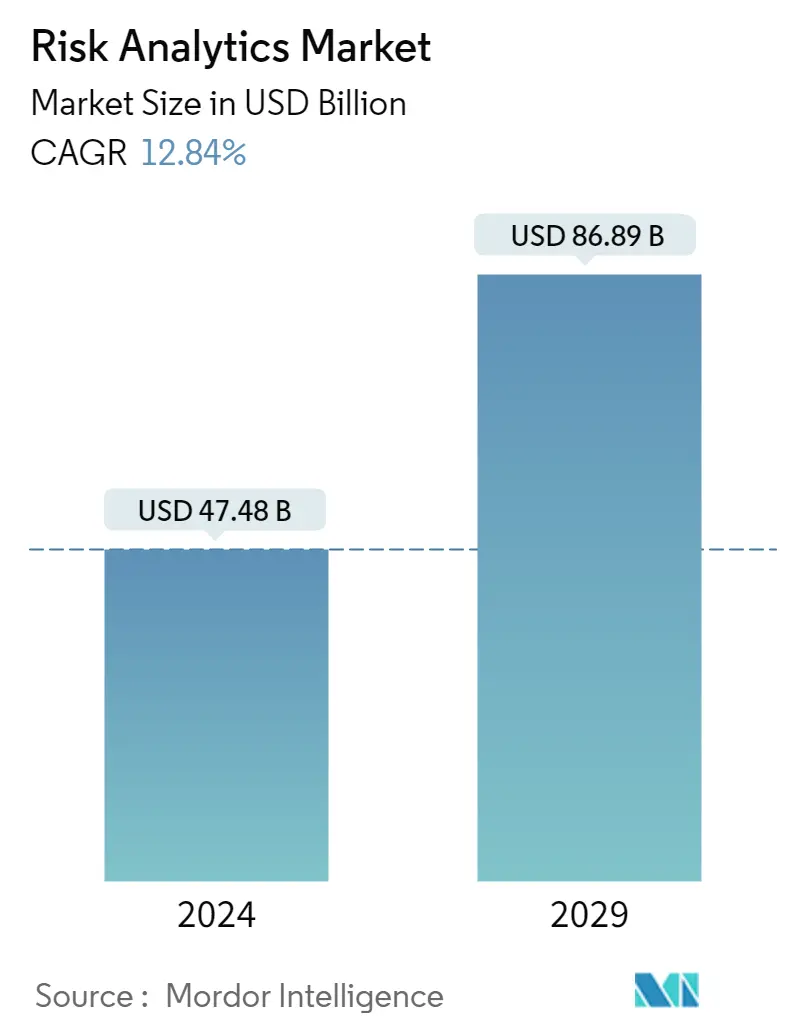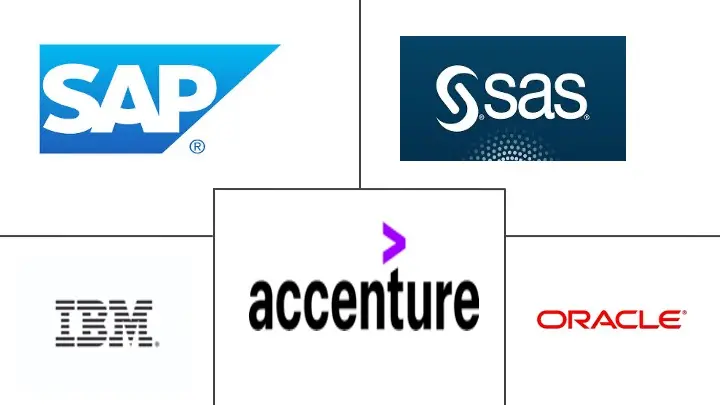Market Size of Risk Analytics Industry

| Study Period | 2019 - 2029 |
| Market Size (2024) | USD 47.48 Billion |
| Market Size (2029) | USD 86.89 Billion |
| CAGR (2024 - 2029) | 12.84 % |
| Fastest Growing Market | Asia Pacific |
| Largest Market | North America |
| Market Concentration | High |
Major Players
*Disclaimer: Major Players sorted in no particular order |
Risk Analytics Market Analysis
The Risk Analytics Market size is estimated at USD 47.48 billion in 2024, and is expected to reach USD 86.89 billion by 2029, growing at a CAGR of 12.84% during the forecast period (2024-2029).
Risk analytics solutions help organizations deal with and protect against operational risks, which can arise due to internal factors, such as human errors, failures of systems (which can be related to software, hardware, network, etc.), and fraud cybercrime.
- Currently, risk analytics techniques are enabling risk managers to measure and predict risk with more certainty than ever before. Organizations are leveraging risk analytics to gather supporting information through various security data sources to quantify their cyber risks, automate their security operations, and make intelligence-driven decisions. Additionally, organizations are witnessing increased regulatory pressure from the cyber perspective with mandates and guidance, such as the PCI-DSS and NIST Cybersecurity Framework.
- The increased usage of large amounts of structured and unstructured data in the various end-user industries boosts the demand for risk analytics to manage and save data from threats. For instance, According to Seagate Technology PLC, the global volume of data is expected to increase to 47 zettabytes and 163 zettabytes in 2020 and 2025.
- Moreover, cloud computing is driving a software revolution astonishingly as any other computing revolution of the past 40 years. As analytics for location-based risk advance, it is only sensible that they can be built and delivered using cloud-based technology rather than older server-based systems. There are several risk assessment and accumulation platforms available now through the cloud. Rules-based approaches to security, whether they are applied to threat detection, investigation, or response, can no longer keep pace with advanced cyber threats, including account compromise and malicious insiders.
- The demand for risk analytics in the banking, financial services, and insurance (BFSI) sector is also fueled by the increased use of mobile banking services and the rising volume of data. Risk analytics can be applied to combine the data into a single, comprehensive perspective, collect essential data, and produce insights that can be put to use. In addition, risk analytics are critical for logistics firms worldwide to efficiently address business disruptions and supply chain issues brought on by the spread of the coronavirus disease internationally.
Risk Analytics Industry Segmentation
A part of a risk management environment, risk analytics is a type of business intelligence. It is optional to use a digital solution; companies have been employing manual or somewhat automated approaches for years to analyze and assess risk. Vendors are offering this software through on-premise and cloud deployment for end-user industries, such as BFSI, healthcare, IT, and telecom, which are considered in this study.
The risk analytics market is segmented by component (solution, service), deployment (on-premise, cloud), end-user vertical (BFSI, healthcare, IT, and telecom), and geography (North America (United States, Canada), Europe (Germany, UK, France, Spain, and Rest of Europe), Asia-Pacific (China, Japan, India, Australia, and Rest of Asia-Pacific), and Latin America (Brazil, Mexico, Argentina, and Rest of Latin America), and Middle East & Africa (UAE, Saudi Arabia, South Africa, and Rest of MEA). The market sizes and forecasts are provided in terms of value in USD for all the above segments.
| By Component | |
| Solution | |
| Service |
| By Deployment | |
| On-premise | |
| Cloud |
| By End-user Vertical | |
| BFSI | |
| Healthcare | |
| Retail | |
| Manufacturing | |
| Other End-user Verticals (IT and Telecom) |
| Geography*** | ||||||
| ||||||
| ||||||
| ||||||
| ||||||
|
Risk Analytics Market Size Summary
The risk analytics market is poised for significant growth, driven by the increasing need for organizations to manage and mitigate operational risks stemming from internal factors such as human errors, system failures, and cybercrime. As businesses face heightened regulatory pressures and the growing volume of structured and unstructured data, the demand for risk analytics solutions is on the rise. These solutions enable organizations to quantify cyber risks, automate security operations, and make informed, intelligence-driven decisions. The shift towards cloud-based technologies is further propelling the market, as it offers scalable and cost-effective solutions for managing location-based risks. The banking, financial services, and insurance (BFSI) sector, in particular, is experiencing a surge in demand for risk analytics due to the increasing use of mobile banking services and the need to address fraud and regulatory compliance challenges.
North America is expected to dominate the risk analytics market, with the United States leading due to its early adoption of technological advancements and the presence of major enterprises. The region's strong foothold of risk analytics vendors, such as IBM Corporation, Oracle Corporation, and SAS Institute Inc., contributes to its market leadership. The healthcare sector is also witnessing a positive trend in predictive analytics, driven by the adoption of cloud computing to protect healthcare information systems from cyber threats. The market is relatively consolidated, with major vendors offering innovative and customized services to meet the diverse needs of end-users. Strategic partnerships and mergers, such as those between Renew Risk and GCube Insurance, and SimCorp and Axioma, are enhancing the capabilities and reach of risk analytics solutions, further fueling market growth.
Risk Analytics Market Size - Table of Contents
-
1. MARKET DYNAMICS
-
1.1 Market Overview
-
1.2 Industry Value Chain Analysis
-
1.3 Industry Attractiveness - Porter's Five Forces Analysis
-
1.3.1 Threat of New Entrants
-
1.3.2 Bargaining Power of Buyers/Consumers
-
1.3.3 Bargaining Power of Suppliers
-
1.3.4 Threat of Substitute Products
-
1.3.5 Intensity of Competitive Rivalry
-
-
1.4 Market Drivers
-
1.4.1 Growing Complexities across Business Processes
-
1.4.2 Global Regulatory Frameworks and Government Policies
-
-
1.5 Market Restraints
-
1.5.1 High Installation and Operational Costs
-
1.5.2 Complicated Regulatory Compliance might hinder the Market Growth
-
-
1.6 Impact of COVID-19 on Overall Market
-
-
2. MARKET SEGMENTATION
-
2.1 By Component
-
2.1.1 Solution
-
2.1.2 Service
-
-
2.2 By Deployment
-
2.2.1 On-premise
-
2.2.2 Cloud
-
-
2.3 By End-user Vertical
-
2.3.1 BFSI
-
2.3.2 Healthcare
-
2.3.3 Retail
-
2.3.4 Manufacturing
-
2.3.5 Other End-user Verticals (IT and Telecom)
-
-
2.4 Geography***
-
2.4.1 North America
-
2.4.1.1 United States
-
2.4.1.2 Canada
-
-
2.4.2 Europe
-
2.4.2.1 Germany
-
2.4.2.2 United Kingdom
-
2.4.2.3 France
-
2.4.2.4 Spain
-
-
2.4.3 Asia
-
2.4.3.1 China
-
2.4.3.2 Japan
-
2.4.3.3 India
-
2.4.3.4 Australia and New Zealand
-
-
2.4.4 Latin America
-
2.4.4.1 Brazil
-
2.4.4.2 Mexico
-
2.4.4.3 Argentina
-
-
2.4.5 Middle East and Africa
-
2.4.5.1 United Arab Emirates
-
2.4.5.2 Saudi Arabia
-
2.4.5.3 South Africa
-
-
-
Risk Analytics Market Size FAQs
How big is the Risk Analytics Market?
The Risk Analytics Market size is expected to reach USD 47.48 billion in 2024 and grow at a CAGR of 12.84% to reach USD 86.89 billion by 2029.
What is the current Risk Analytics Market size?
In 2024, the Risk Analytics Market size is expected to reach USD 47.48 billion.

